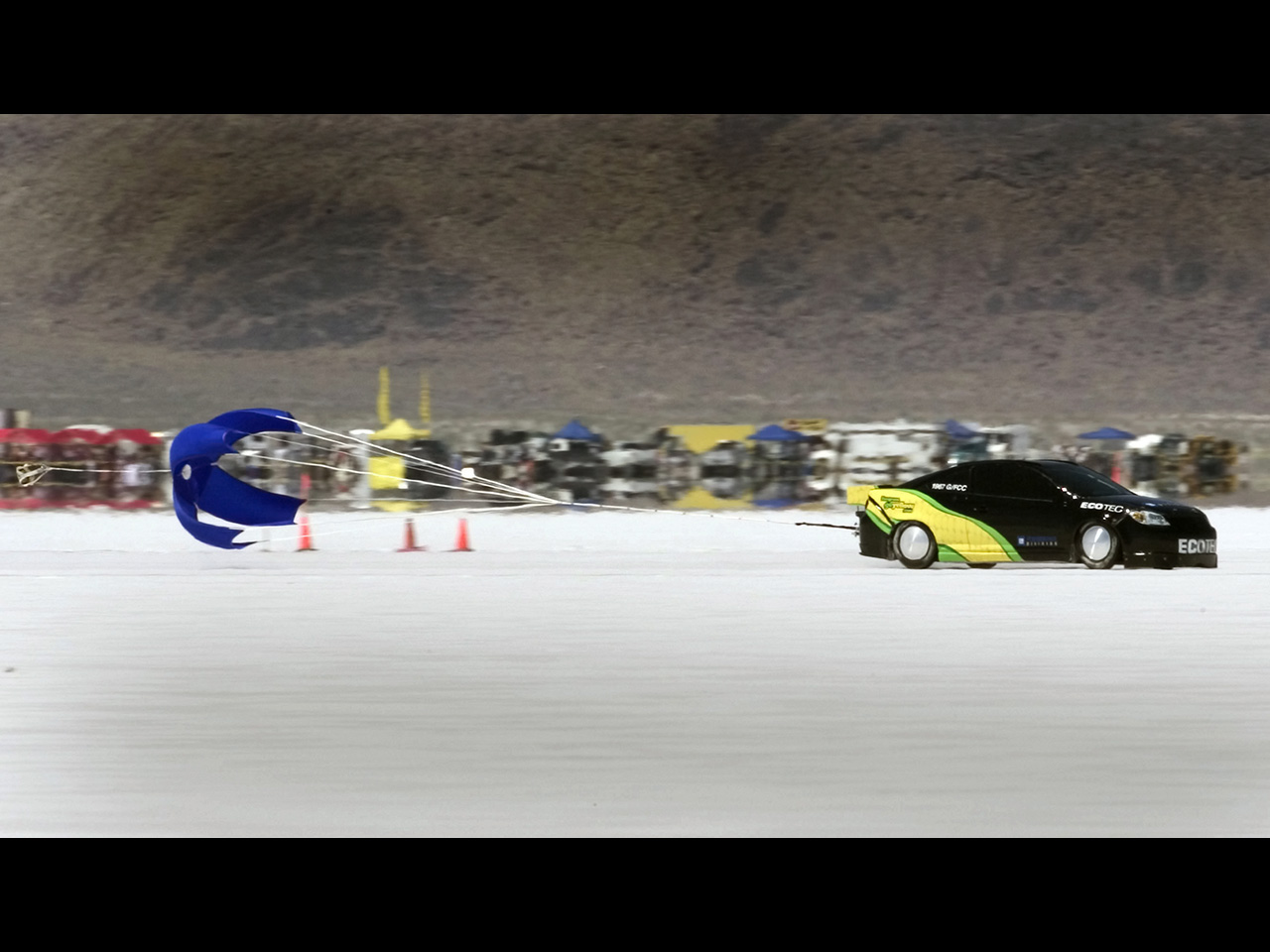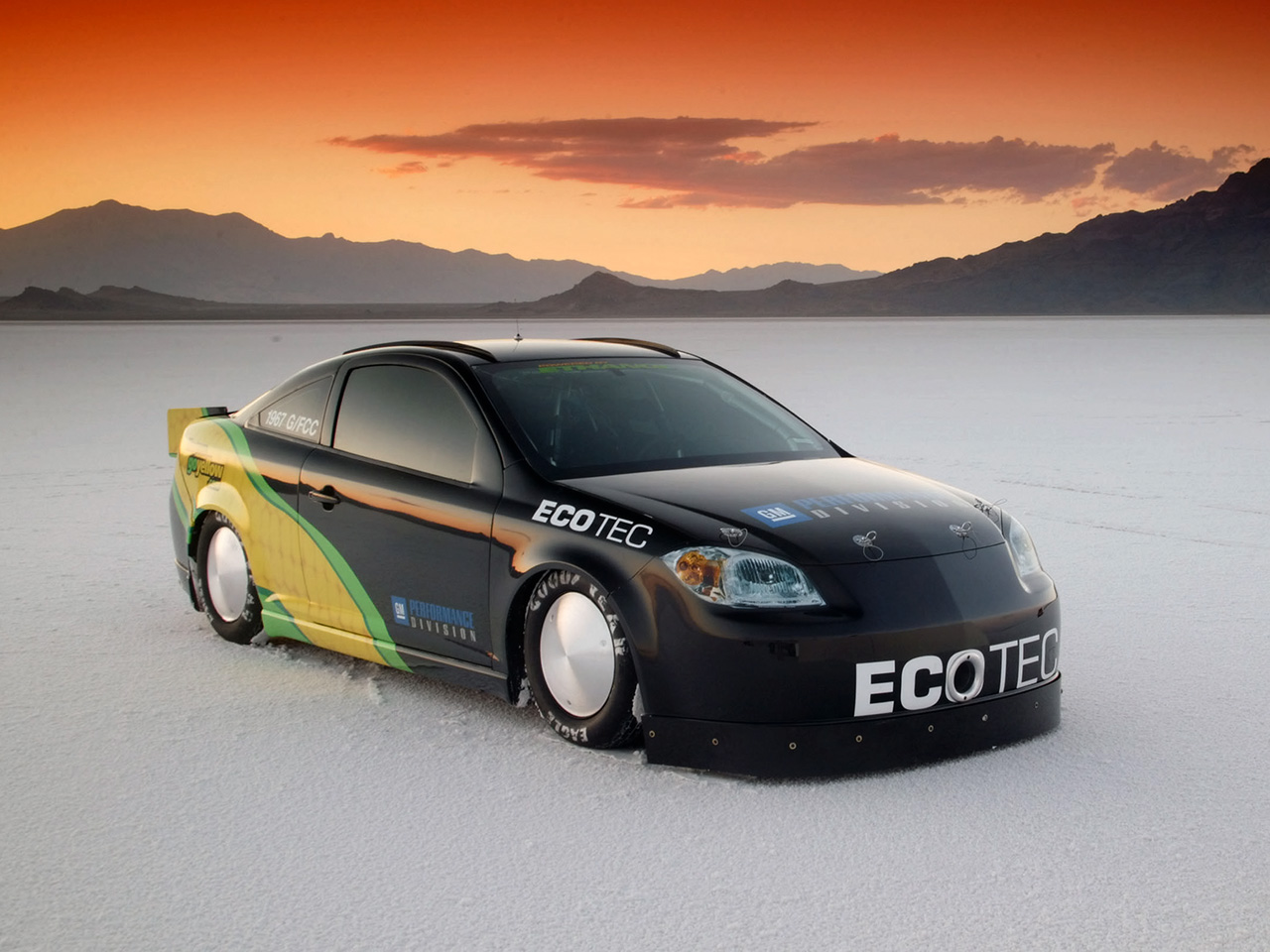2006 Chevrolet at the Bonneville Salt Flats
(from GM Press
Release) Chevrolet Sets Three New Land Speed Records at the
Bonneville Salt Flats GM Performance Division and its
partners from So-Cal Speed Shop set three new land speed records
with Ecotec-powered vehicles last week during the 58th Annual Speed
Week event at the Bonneville Salt Flats in Wendover, Utah, including
the first-ever Bonneville record using E85 ethanol. Ecotec-powered
vehicles have now set eight records during the past four years with
some form of GM involvement.
“The Ecotec is one of the most adaptable and durable four-cylinder
engines in the marketplace, and it continues to prove its mettle on
the hallowed Salt Flats,” said GM Performance Division executive Al
Oppenheiser, whose team heads up GM’s efforts at Bonneville. “We
even had one impartial member of the media call the engine
‘bulletproof’ last week, which is a testament to our powertrain
organization.”
The team never looked back after setting two records on Aug. 13 in
the G/FCC class (G class/Unblown Fuel Competition Coupe) with the
Bonneville Student Project Chevy Cobalt ss and the G/BFALT class (G
class/Blown Fuel Altered Coupe) with the Chevy So-Cal Cobalt ss
during the first record return runs of the week.
Both cars were driven by GM Performance Division engineer Mark
Dickens, and each vehicle upped its initial record in subsequent
race runs throughout the week.
Running only on E85 ethanol, the Student Project Cobalt ss broke the
previous 19-year-old record of 152.626 mph set by Doc Jeffries in
1987 with a speed of 156.073 mph, and then upped that record twice
using E85 combined with nitrous oxide to its final mark of 172.680
mph in the G/FCC class (G class/Unblown Fuel Competition Coupe).
The car either qualified or set a record in every E85 race run of
the week, and was converted to run on the renewable fuel by three
female engineering student interns – 19-year-old Heather Chemistruck
from Virginia Tech University, 21-year-old Lauren Zimmer from Purdue
University and 21-year-old Sandra Saldivar of New Mexico State
University .
“The fuel classes at Bonneville are wide open, and that allows a
person to run anything from nitro-methane to methanol to gasoline
and whatever else is out there,” said Dickens. “We put E85 up
against some of the absolute most extreme fuels available, and to be
able to initially break the record using only E85 is quite an
accomplishment.”
Meanwhile, Dickens shattered the record he set on Aug. 13 in the G/BFALT
class (G class/Blown Fuel Altered Coupe) with a speed of 246.849 mph
in the Chevy So-Cal Cobalt ss on Aug. 15, more than 28 mph better
than his previous mark of 218.392 mph.
With his initial G/BFALT record, Dickens earned his place in the
Bonneville “200 MPH Club,” joining fellow GM engineer Jim Minneker
in the exclusive land speed record fraternity, which is a little
more than 600 members strong.
“They told me more people had been in outer space than are in this
club,” said Dickens. “Whether it’s true or not, it is an honor to be
mentioned in the same breath as some of those drivers.”
The Haas Roadster, owned by Haas Racing and built in partnership
with So-Cal Speed Shop, set a new record in the G/BFMR class (G
class/Blown Fuel Modified Roadster) with a speed of 196.106 mph. The
Haas Roadster features a 2.0-liter Ecotec turbo and was driven by
team member David Haas.
The team did have a couple setbacks during the week, proving just
how hard it actually is to set a record at the Salt Flats,
especially when considering a vehicle has to make two successful
runs to set a new record.
Once a vehicle qualifies to beat the previous record, it is
immediately impounded until the next morning when it can return to
the same course for a record run. The combined average between the
qualifying and record return runs are what establish a new record
After only two passes, the Chevy So-Cal HHR was finished for the
week on Aug. 14 due to an on-course incident.
GM engineer and driver Jim Minneker was beating the previous record
of 226.835 in the G/BFCC class (G class/Blown Fuel Competition
Coupe) by more than 20 mph with a qualifying run of 246.686 mph when
the HHR lost traction after parachute deployment at the end of its
run. Minneker walked away with only minor bruises, and although the
HHR was still structurally intact, it was unable to continue
running.
And after upping its own record in the G/BGL class (G class/Blown
Gas Lakester) last year to 189.205 mph, the Ecotec Lakester made two
passes late last week at speeds of 210.970 mph and 209.360 mph, but
did not qualify for a record return run because the mark had already
been broken with a higher speed of 212.765 mph on Aug. 16.
“We came out here to set records and showcase GM’s engineering and
performance capabilities in a uniquely American environment,” said
Oppenheiser. “We had an outstanding week with the Cobalts, and we
don’t think either of those records will be broken anytime soon. And
besides, there is always the World Finals in October.”
“Plus, we also proved that there is definite performance benefit to
using E85 since it burns cooler than gasoline and has a higher
octane rating, and not only is it good for the environment from an
emissions standpoint, but it’s also a viable option for racing.”



